- How to Spend One Day in Toyama - 25 July 2024
- Where to Stay in Nagano: Good Areas & Hotels to Consider - 20 July 2024
- 3 Mistakes Not To Make If You Visit Narai Juku - 17 July 2024
Tokyo is not a friend to the early riser – or the jetlagged. On one recent trip, I woke up every morning around 5 am and, after a couple of hours enjoying lounging about, I was raring to explore this exciting city – but, nothing, it seemed, was open much before 11 am. Until I started looking more closely, and realized there is actually a lot to do in Tokyo before breakfast. So, here’s my guide to early morning Tokyo…
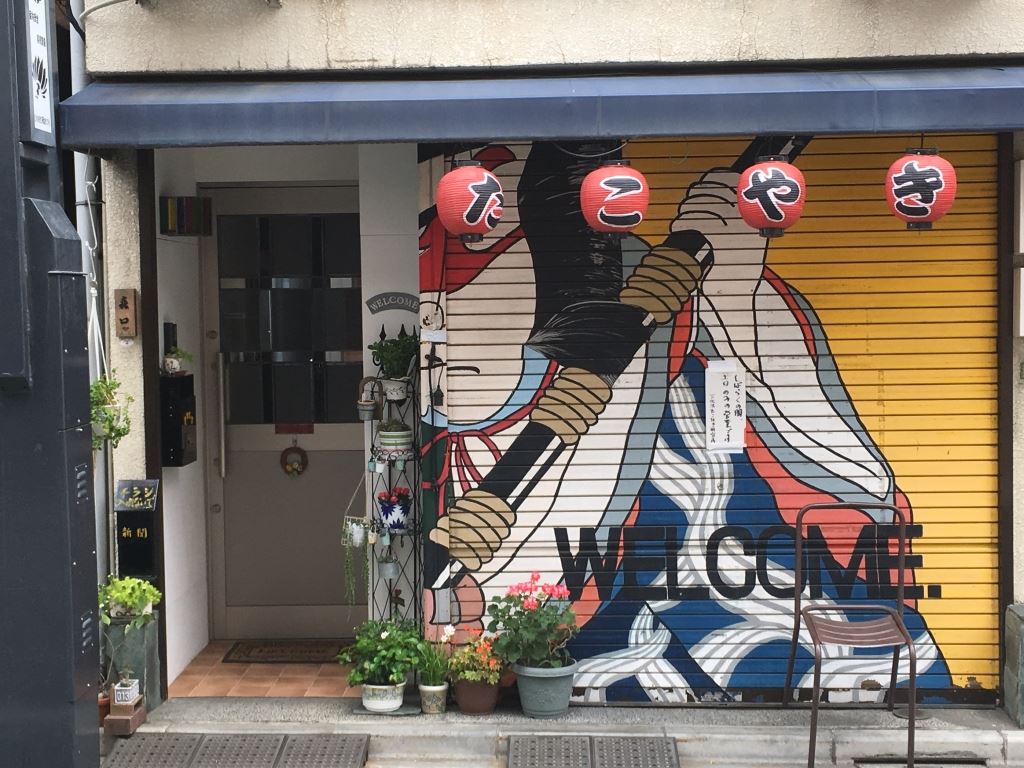
Article by Helen Foster. Disclosure: Some links in this post are affiliate links. See our Affiliate Disclosure.
This post first appeared on Japlanease’s sister blog Differentville in 2018. It was moved here in July 2022. Last update January 2024
17 Fun Things to Do in Tokyo – Before 10 am
1. Go See Thousands of Waving Cats
Shrines and temples are great things to do in the early morning in Tokyo; they are often open 24 hours, or at least open extremely early, and by going before breakfast you usually beat the crowds.
One place where this definitely pays off is Gotoku-ji in Tokyo’s South East.
Known as the temple of beckoning cats, this is actually a large space with an impressive pagoda, numerous outlying buildings, and a cemetery to walk around, but what brings the tourists here is the area of the temple which is lined with thousands of white maneki-neko, the lucky, waving cat.
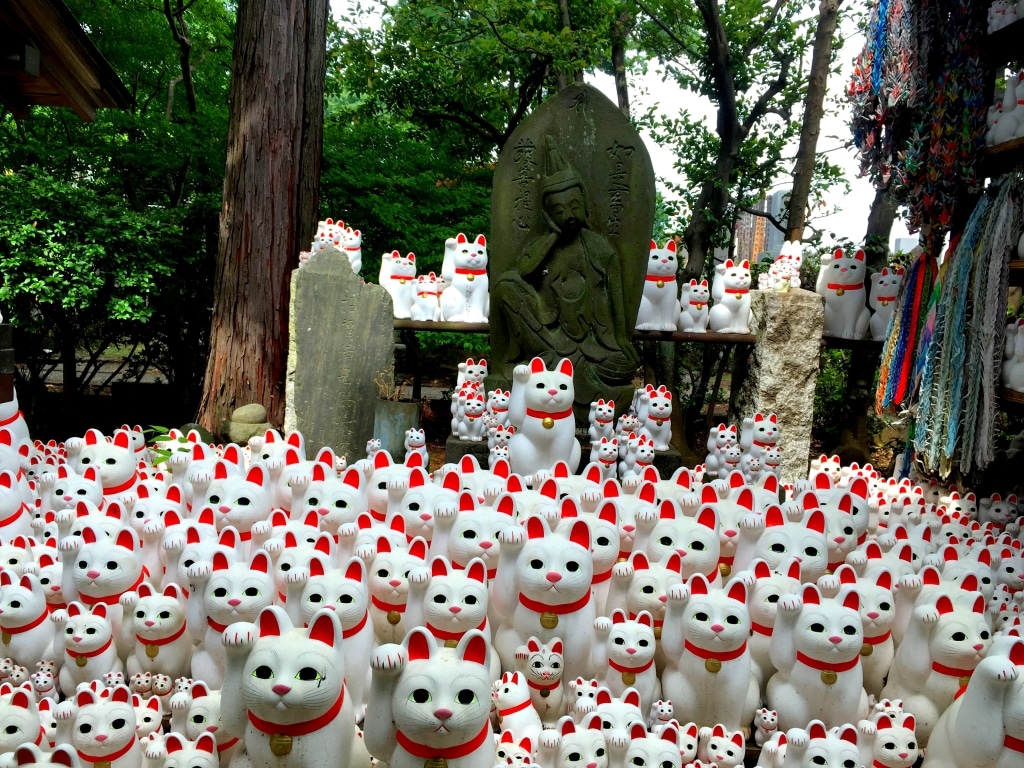
The area containing the cats, however, is very small, if there are more than about four people in it, it feels crowded. Getting there first thing gives you more opportunity to have the place to yourself – and the best chance of awesome pictures.
Gotoku-ji opens at 6 am and is about a 30-minute journey to Gotokuji station on the Odakyu line from Shinjuku. Miyanosaka on the Tokyu-Setagaya line is a little bit nearer to the temple entrance and you can connect to this via the Odakyu line or the Keio Line.
Most shrines and temples in Tokyo open early, so if Gotokoji isn’t your kind of thing, have a look at our post on the 10 best shrines and temples in Tokyo to find somewhere else to spend your morning.
2. Soak in an Onsen
Onsens are the hot springs of Japan – gorgeous, warm baths in which you can soak away your cares, your aches, or the early morning hours when everyone else is asleep!
Thermae Yu in Shinjuku is now the biggest onsen in Tokyo and it’s open 24 hours making it the perfect place to spend the early morning in Tokyo.

Admittedly, the first time I went to an onsen, I was terrified – for starters, there’s etiquette involved. You need to make sure your whole body is cleaned before you enter the baths and I really wasn’t sure what to do when, but possibly the most scary thing is – you have to go in completely nude. Panic. Panic, Panic.
I ummed and ahhed on my first trip about whether to do it, braved it, and rapidly realized the only person in there caring about my naked butt was me!
Plus, you’re given a small ‘draping’ towel that you can subtly position over at least some of your lower half.
Going early further reduces some of that embarrassment though as it’s the least busy time of the day – peak hours are around 4-10 pm, and between 6 am and 9 am you’ll hardly see a soul.
See more on their website. You’ll need to use Google Translate as it’s only in Japanese.
Or, if you already like the sound of soaking your cares away but don’t want to deal with translation, you can buy a ticket on Klook – but note, this doesn’t allow entry until 9am.
3. Visit Shimokitazawa
Famous for its cool vibes, vintage shops, dive bars, and coffee places, you might wonder why I’m telling you to go to uber-hipster Shimokitazawa first thing in the morning when all of these things are closed. The answer is – shutter art.
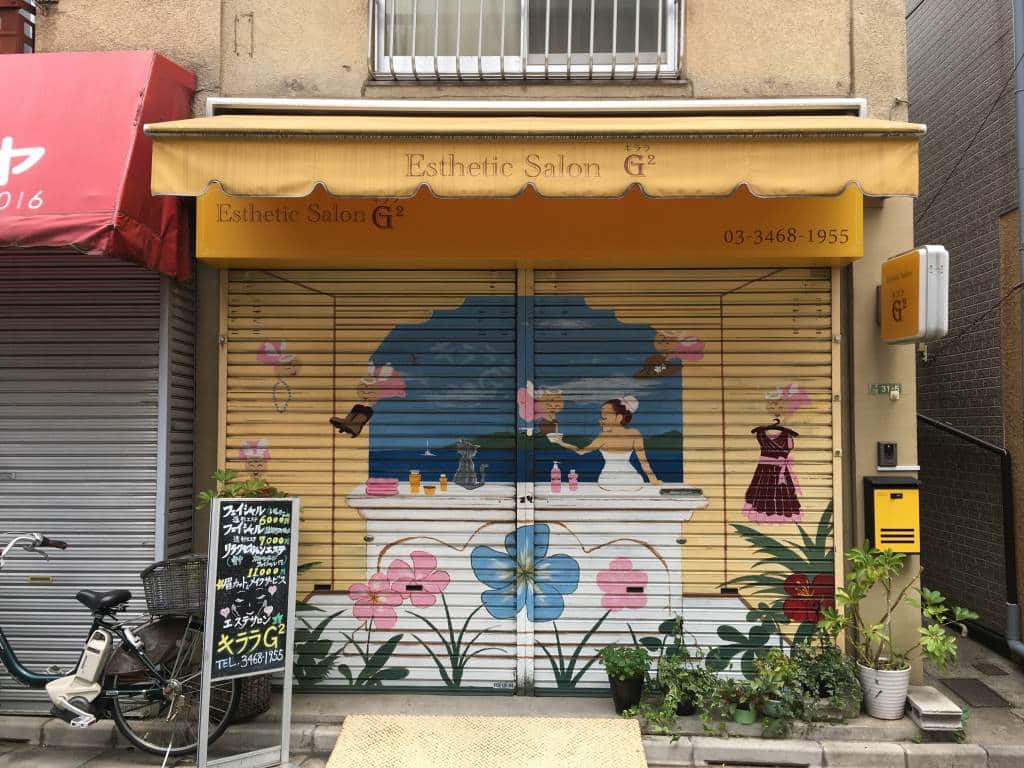
Tokyo doesn’t have a lot of street art in the same way other cities do – you won’t find many huge murals dominating walls in the city, but what it does have are paintings on the shutters of shops that you can only truly see when the shops are closed. Some of the best examples of this are in Shimokitazawa – now do you see my logic?
Some of the art reflects what the shop sells; others are just random murals, but you can only really appreciate it all early in the morning.

Oh, and don’t believe everything you read about Shimo not opening until after lunch – I got there a little after 10.00am, and some shops were opening up.
For the best timing, I’d say get there about 9.30am, wander around the shops checking out the shutters for an hour or two, and then, explore again once they open.
4. Get Some Ramen
I appreciate that you can do this at any time of day in Tokyo, but bear with me.
For starters, queuing for food is not abnormal in Tokyo; people happily line up for 3-4 hours to go to a restaurant they think is worth the wait.
I don’t know about you, but when you’ve only got a few days in a city, spending that long standing in one place does not sound appealing. However, when it comes to one of Tokyo’s most popular ramen joints, you can beat the system by eating it early.
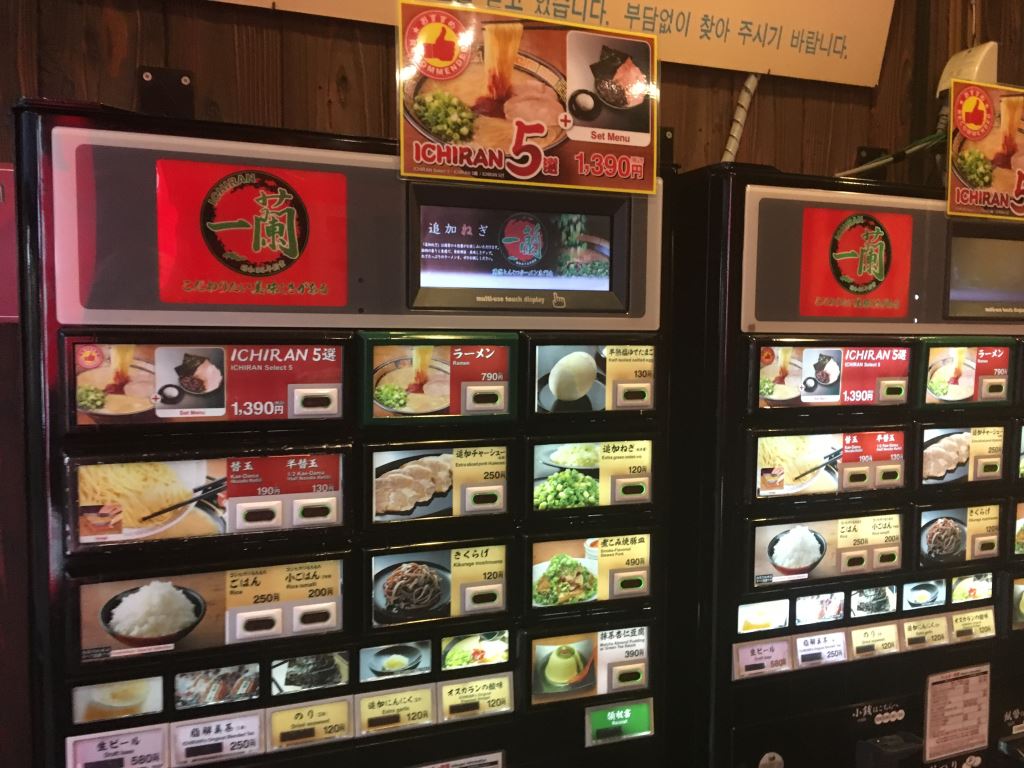
It’s a chain called Ichiran Ramen – Forbes magazine even went as far as to call it ‘the best ramen in the world?’ because of how they allow you to customize the bowl to your exact needs, and queues here can be loooooong.
But some branches, including the two in Shibuya and the branch in Ueno are open 24 hours, and when I rocked up 9 am one Sunday morning there was no line at all.
If you’ve never had soup for breakfast, give it a try – it fuels you brilliantly for a long day of sightseeing. From personal experience, I can tell you it’s better than a fry-up for making you feel human again if you’ve overdone it a bit the night before!
Click here for a full list of branches and their opening times – if it says 10-6 – that means 6 am the next morning, not 6 pm that night.
Top Tip
Ichiran has a unique ordering system, so, if you want to know what to expect before you arrive, have a look at our post on ordering from a Japanese ticket machine. The Ichiran section is at the end.
5. Watch Sumo Practise
While you can pay for tours that get you inside a sumo stable to watch the practice, you can also go it alone and watch from just outside for free.
Arashio-Beya sumo stable in Nihonbashi lets people watch their practice from the street through their giant windows.
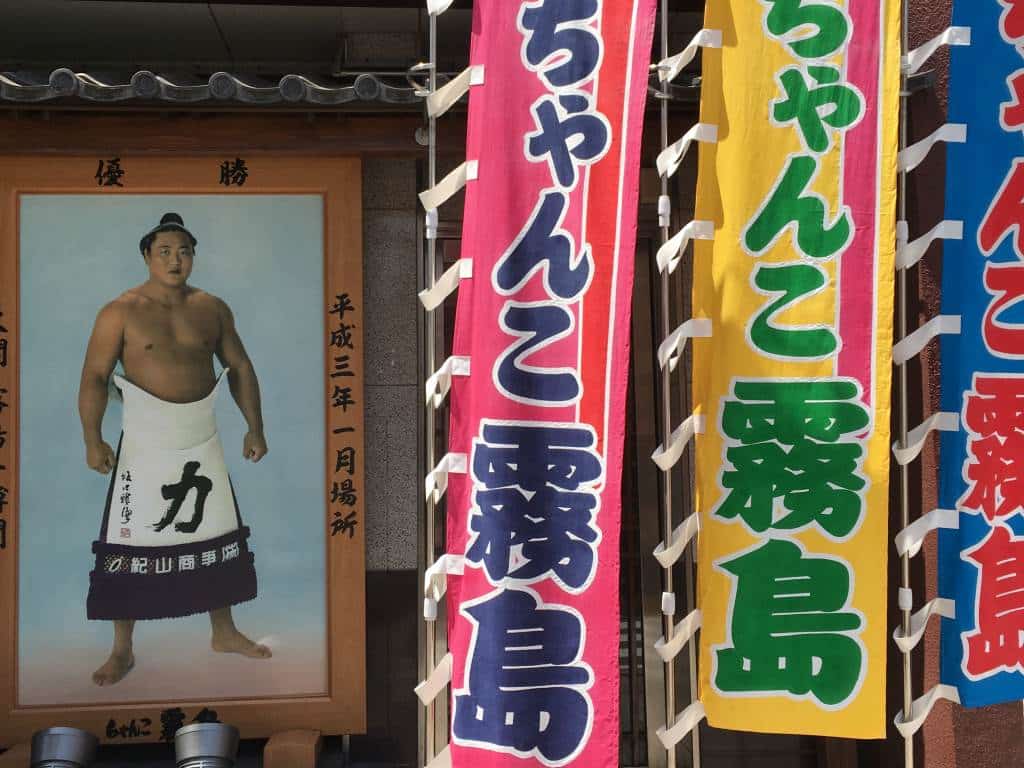
They practice from 7.30am to 9.30 am most days. You used to have to call them to confirm, but now they have a website which shows the training schedule.
They don’t allow visitors to watch training just before the big Sumo tournaments.
The stable only speaks Japanese but don’t worry as they give you an outline of what to say here or, ask your hotel to give them a call for you.
Where to Book a Sumo Tour
If you prefer to get a closer look, and a better understanding of the practice, you can book tours to see early morning Sumo practice.
Taking a tour not only ensures you get to see the guys in action, but your guide will also explain all the nuances of this sport.
6. Visit The Fire Temple
I actually didn’t mind missing out on the Sumo too much as it meant I clawed back an hour that allowed me to head to Fukagawa Fudo-do temple about half an hour’s walk from Nihonbashi and watch the most amazing ritual there.
The Goma Ritual uses a mix of chanting, drumming, prayers – and fire – to strengthen the energy of the god Fudomyo-o. I can’t show you it as you can’t take pictures inside, so you’ll just have to go and visit
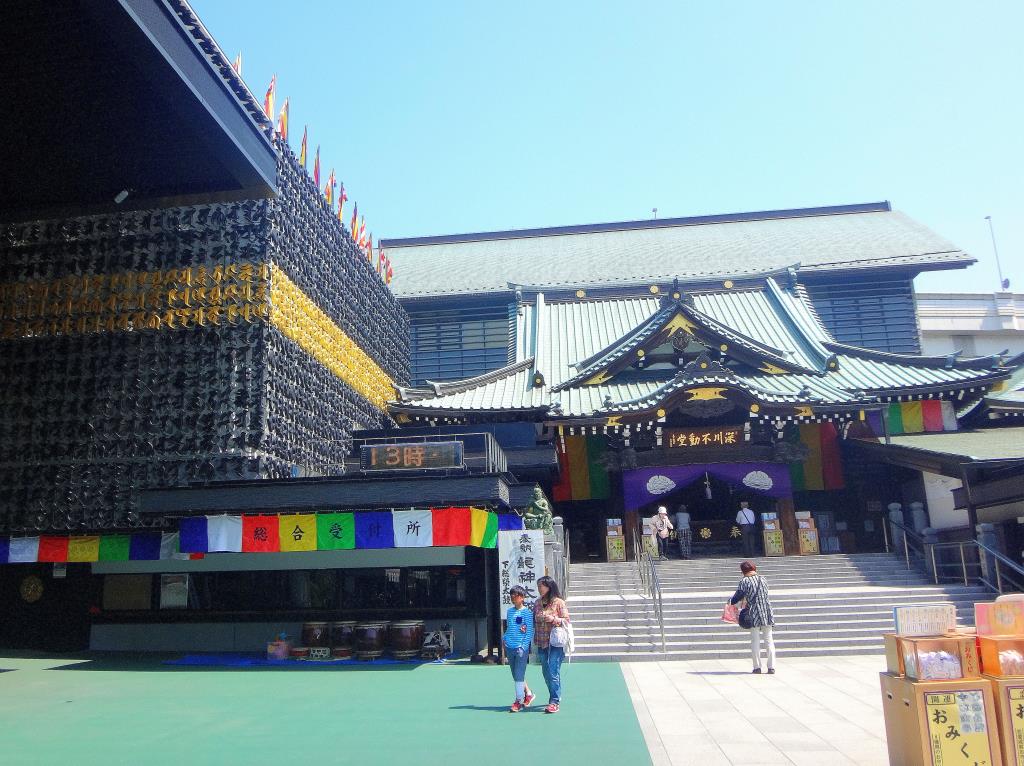
It takes place 5-6 times daily, with the first rite at 9 a.m., although the temple itself opens at 8 a.m.
The rite lasts around 30 minutes and while I didn’t really have a clue what was going on, it was amazing to watch. Priests are blowing into conch shells, others are drumming, the priests and the congregation are chanting, and, in the middle of it all, a man is sitting by a huge flame and much burning of blessings and wooden sticks for people who have asked for help.
At the end of the rite, people went up to get their handbags blessed by the flames. While I understand the concept, I can’t find out why, specifically, handbags are held over the fire, so if you know, please tell me in the comments.
The temple also has a few other interesting touches, including nearly 10,000 crystal statues, a bridge inside that people cross for luck, and a second floor that allows you to do one of Japan’s most holy pilgrimages without even leaving Tokyo. It’s also where you go to get your car blessed for road safety – so expect to see a few vehicles lined up alongside.

If you’re looking for somewhere to write all your Japan plans check out our Japan-themed notepads on Amazon.
With 120 lined pages they are perfect for planning all the elements of your Japan visit.
7. Go to Tsukiji Outer Market
Tsukiji is best known in Tokyo for the fish market based here until late 2018. That has now moved to nearby Toyosu, but the Tsukiji Outer Market is still in the old area and it’s an amazing place to spend a few hours – and much better for sightseeing than Toyosu.
If you’ve already read our post on Tsukiji Outer Market you’ll know I could visit here time and time again.
The traders here are happy to see you, and will try to explain things to you if you look confused enough about what something is. Importantly for the foodies among us, they can also actually sell you things, and between that and the free samples that many stalls offer, you can happily munch your way around it for a good two hours.
Before 9 a.m., preference will be given to trade customers (see this guide to etiquette), but you can still visit with that in mind. It’s now very busy from about 10 a.m., so definitely get there early if you want to sightsee rather than just eat.
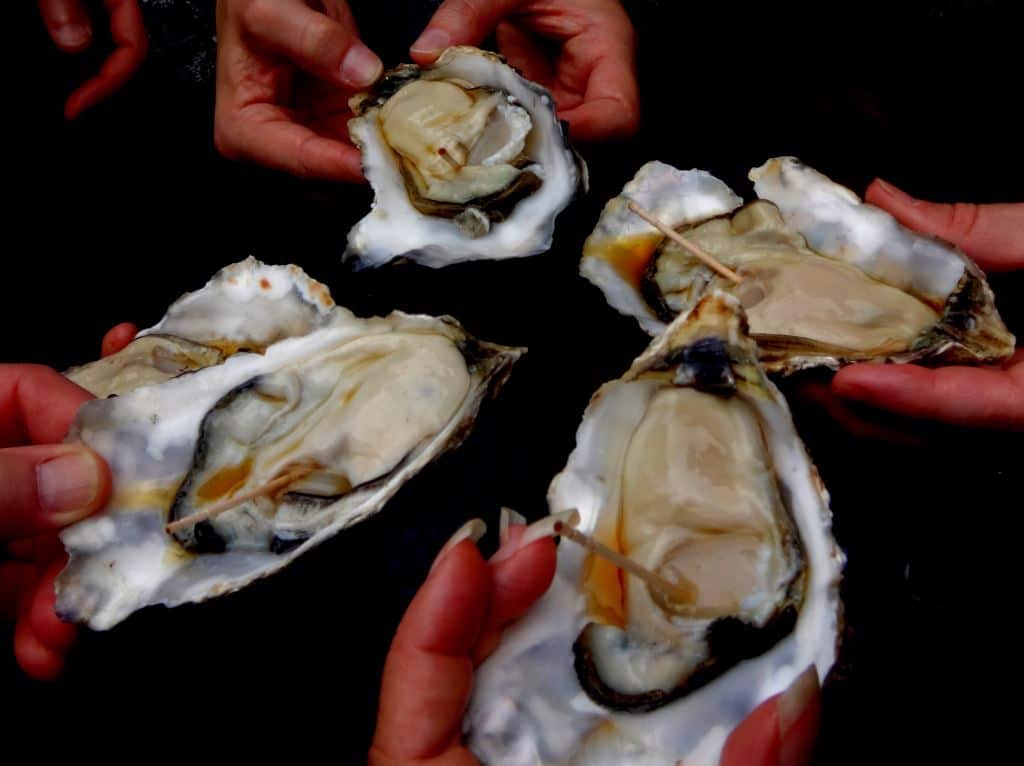
I think it’s absolutely one of the must-see spots in Tokyo for any visitor – particularly if it’s your first time in Tokyo
The outer market starts at 5 a.m., although exact opening times vary from stall to stall. Most stalls stay open until 2 p.m.
If you want to see all the raw fish, make sure you don’t miss the newer buildings opened at the end of the market closest to the Namiyoke Inari Shrine. You can buy super fresh sashimi samples here and eat them on the 3rd floor.
Should You Take a Tour of Tsukiji?
You don’t have to, but if you want to understand the market and the food, one of the best ways is to take an early morning tour.
On the trip I chose to do this, I ate more and learned far more about how the market works, tried samples from the best stalls, and explored areas I wouldn’t have seen without the tour.
8. Eat at Toyosu Market
While Tsukiji sells all sorts of foods to try, the restaurants at Toyosu Market specialize in incredibly fresh fish – and, if you can get here before 10am, you’ll be able to eat an amazing breakfast without the queues (or chaos) that comes with a visit to Tsukiji Market.
The market itself is not worth visiting as you can barely see anything now, but I do recommend a trip to the restaurant area.

Two of the big-name restaurants here are Sushi Dai and Sushi Daiwa and they have queues from before they open, but you won’t go wrong with a meal anywhere here.
Toyosu is a bit out on its own, but in our four-day plan to see Tokyo, I explain how to best fit a visit to Toyosu into your plans.

Need Extra Planning Help?
Our Japan trip planners can help. Choose from our 62-page Japan Super Planner, which includes tips on everything from picking hotels to sightseeing. Or, try a specific planner like Tokyo Tips, Kyoto Tips, or the Rail Pass Planner. Find them at our Etsy Store. Use code BLG25 at checkout to get 25 per cent discount.
9. Buy All The Things in Don Quijote
Donki, as it’s known in Japan, is a maze of things you didn’t know you needed. Some of them you might not even know existed until you walked in through the door.
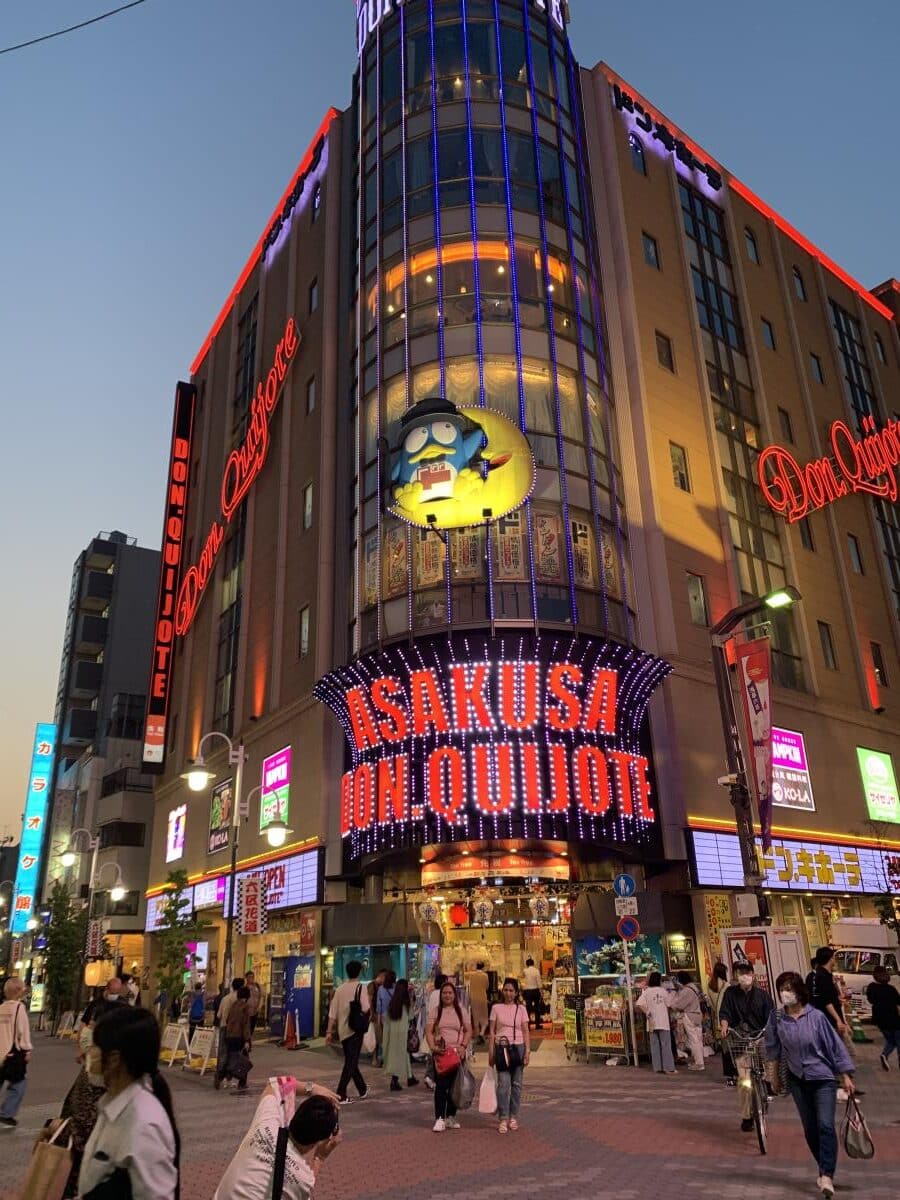
Now, while most shops in Japan don’t open until around 10 a.m., some of the bigger branches on Don Quijote—including the two branches in Shinjuku and the one in Asakusa—are open 24 hours, allowing you to head in there first thing in the morning.
10. Go to See Fuji-San
Mount Fuji is not that far from Tokyo – in fact, on a clear day, you can see it from some of the taller buildings – which makes it one of the good things to do as a day trip from Tokyo.
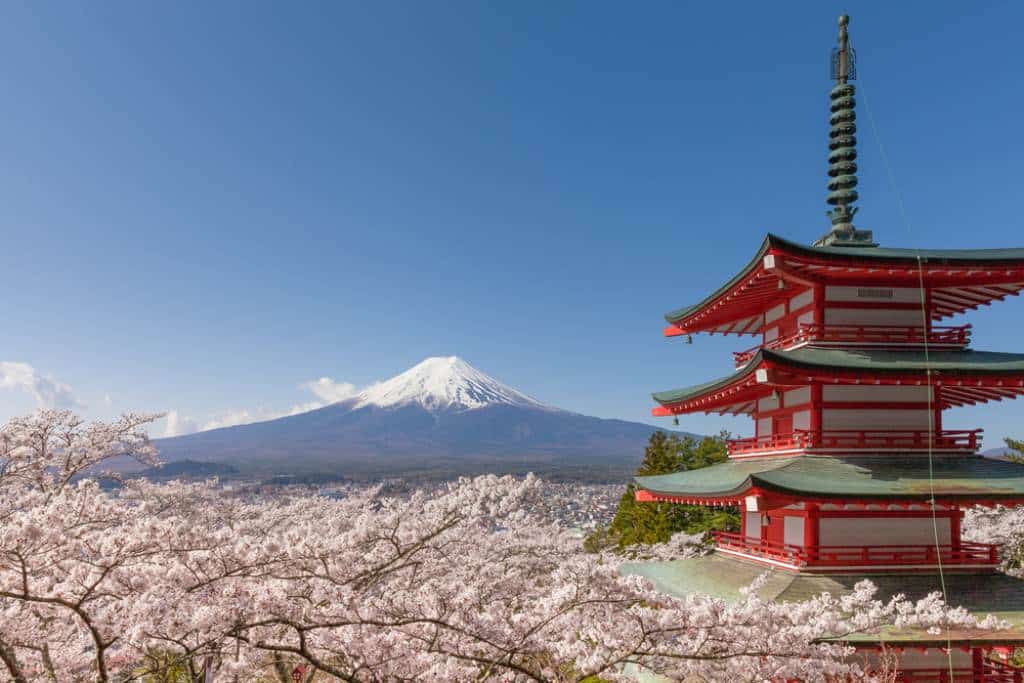
The closest station to Mount Fuji is Kawaguchiko, which is about two hours away from Tokyo by the Fuji Excursion Limited Express train from Shinjuku Station. The first train leaves Shinjuku at 7.30 am and it gets you to Kawaguchiko at 9.26.
The early trains do book out, so, while it’s ideal to visit Fuji or a day with good visibility, you might not be able to get on an early train if you leave it too late to book.
Book advance tickets for the Fiji Excursion train here.
Why Not Take a Tour to Mount Fuji
If you’re not keen on organizing your own day trip, there are plenty of early morning tours from Tokyo to Mount Fuji.
If you want to see the view above, make sure your tour includes the Chureita Pagoda, sometimes just called the five-storey pagoda.
Some tours visit Hakone, a hot springs area with great views of Fuji – and a heap of other things to do as well.
11. Get a View From Above
There are three towers in Tokyo with amazing views, but only two open before 10am.
Tokyo Tower, the smaller of the three, opens at 9 a.m. every day. Tokyo Skytree normally opens at 10 a.m., but on days when they expect it to be busy, they open at 9 a.m. and sometimes even 8 a.m., so check the hours during your visit. Find their opening hours here.

On a clear day, you might even see Mount Fuji – although clear days in Tokyo are few and far between, I found that early morning usually offered the clearest skies, making the days when Tokyo Skytree opens early very handy.
12. Visit a Garden
A short walk from the heaving madness of Shinjuku is the elegant and peaceful Shinjuku Gyoen Garden, which opens at 9 am.
It offers three different types of gardens to visit—an English flower garden, a more formal French-style garden, and, of course, a traditional Japanese garden. And yes, if you’re here in cherry blossom season, it has those, too—but you might need to make a reservation on weekends or any public holidays when the flowers are in bloom. Note: it’s closed on Mondays.
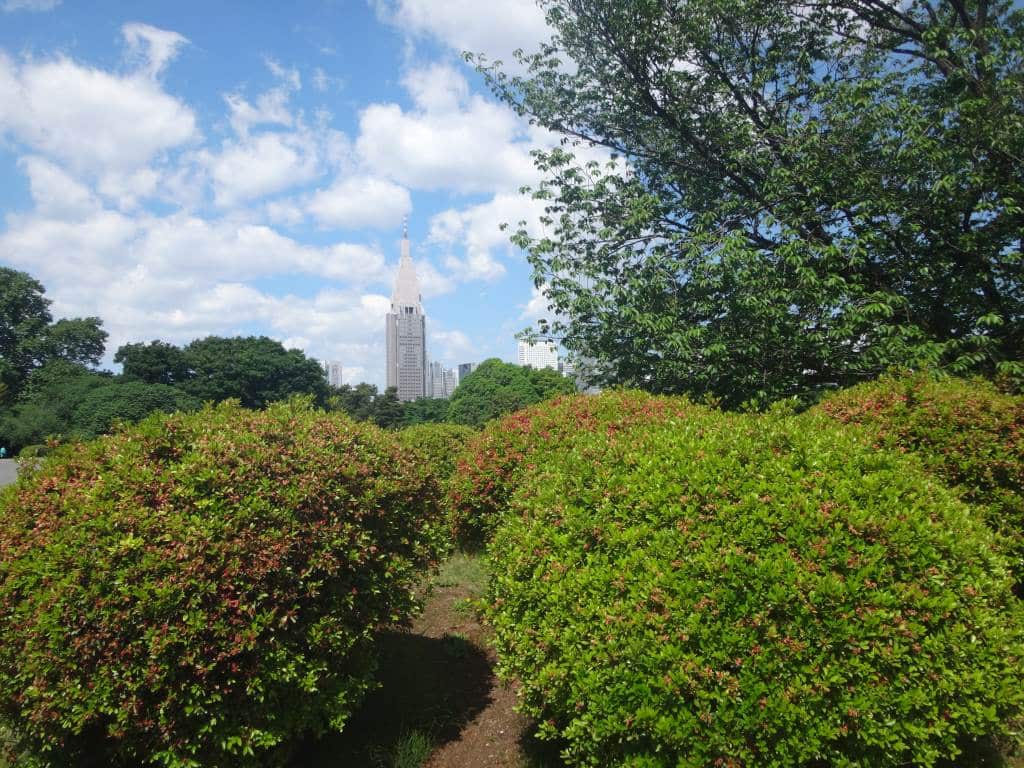
But it is Monday, you cry…. don’t worry, Hama-rikyu Gardens near Shinbashi is absolutely stunning, open seven days a week and also opens its gates at 9 am (it’s also easily combined with a trip to Tsukiji), or try the smaller but still super cute Kyu Shiba Rikyu Garden, which has great plum blossoms during their season.
13. Go on a Hachiko Tour
Most people who end up in Tokyo hear about the faithful dog Hachiko. If you’re not yet familiar with the story, here’s how it goes.
Every day, Hachiko used to follow his owner, Professor Ueno, to their local station, Shibuya, where he caught the train to work. At night, Hachiko would wait at the station for Professor Ueno to come off the train—until, one day, he didn’t. Professor Ueno had had a fatal brain hemorrhage at work.

Hachiko, however, didn’t give up. He kept going to the station every day for the next ten years (feel free to sob right now).
There’s now a statue of the faithful dog at the point where he used to wait outside Shibuya station, and early morning is the best time to get a photo of it without 200 other people in it.
But the main Shibuya statue isn’t the only tribute to the most famous dog in town – you can see the statue above of what would happen if Hachiko and Professor Ueno met again, there’s a Hachiko compass – and more. See our Hachiko tour post for exact details. but you can start it early.
14. Wander around Yanaka Cemetery
This is one of the biggest cemeteries in inner Tokyo, and you can wander around looking at the ornate graves for ages. It’s the final resting place of many important Japanese people, including the last shogun, Tokugawa Yoshinobu.
The cemetery is also famous for the many stray cats that have made their homes among the gravestones, but on my last visit, I didn’t see any, so I’m not sure if they’ve moved or if they were just hiding from me.
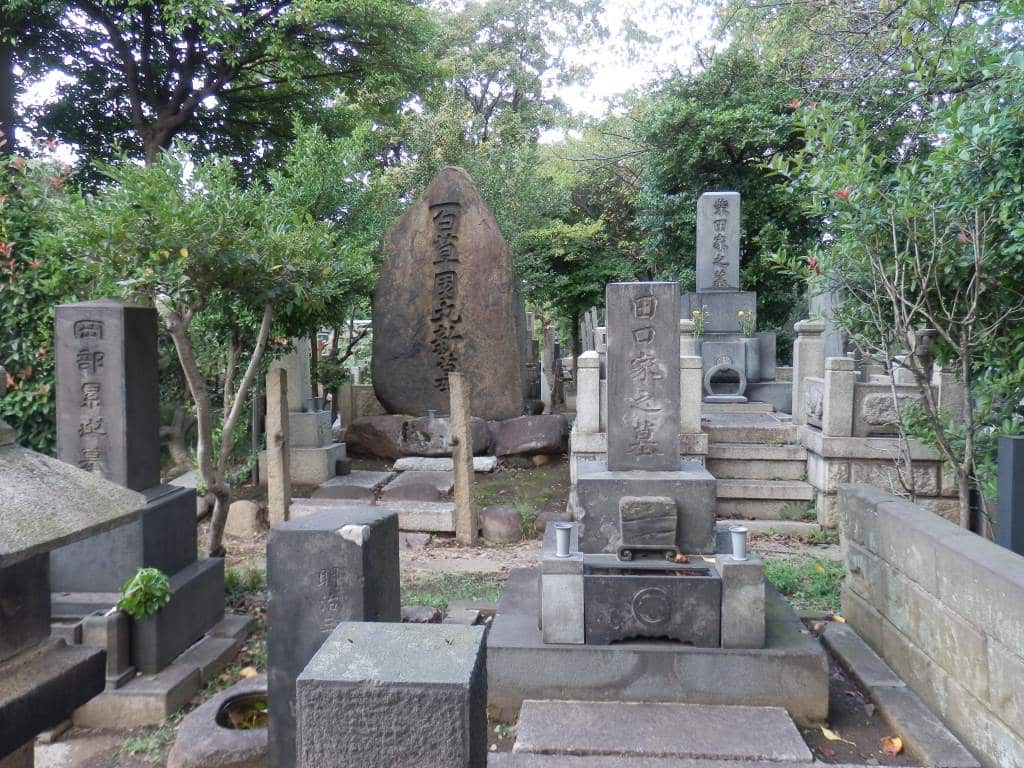
The official website says the office opens at 8:30 a.m., but I am pretty sure the entrance I went through didn’t have an actual gate, so you may be able to wander before then.
The cemetery is also a short walk from the Nezu shrine, which has a stunning walkway of mini-Tori gates that is open 24/7. That’s also in our list of top Tokyo Shrines.
When the rest of the neighborhood wakes up, take a trip to Yanaka Ginza, an old shopping street with a quirky cat theme.
Then Take a Tour of Yanaka
You can book morning tours of Yanaka, which let you see the above with a guide – they start at 10am, so take a wander around the cemetery first, then join your tour.
15. Check out Some of Tokyo’s Oddest Buildings
A building doesn’t need to be open for you to appreciate its outside, and Tokyo has some fantastically quirky ones to choose from. A quirky architecture tour is a great way to spend an early morning in Tokyo. Some of my favorites include…
The Aoyama Technical College Building close to Shibuya which looks like a robot
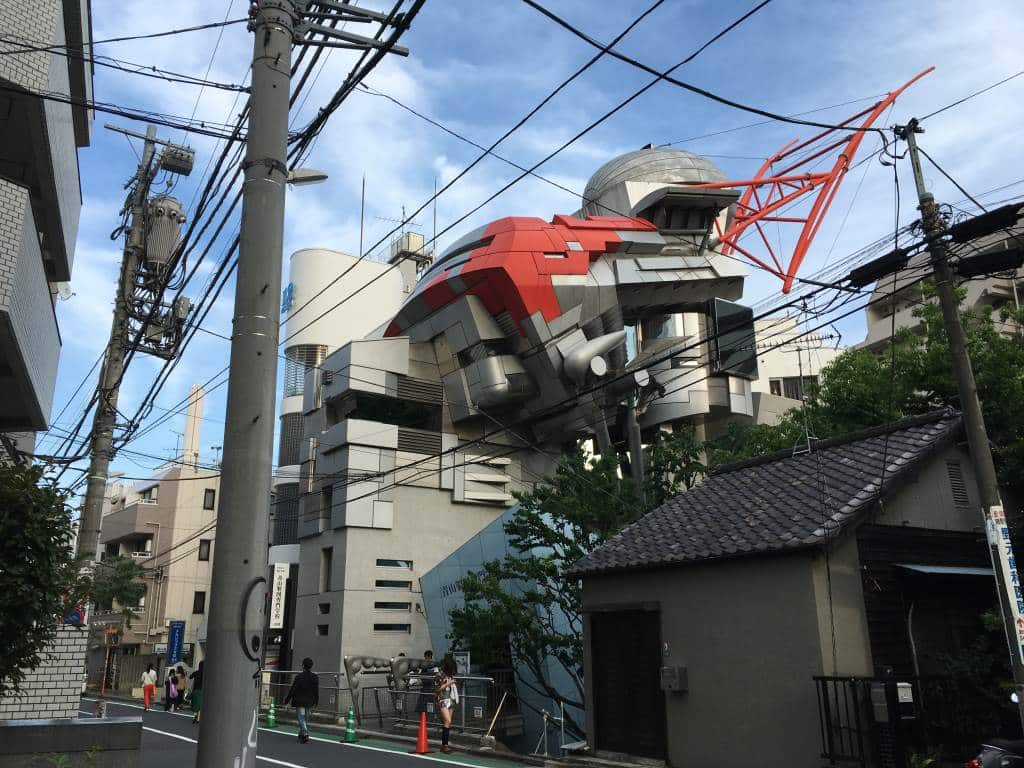
The Shibuya Spaceship – home to the Disney store in Shibuya this black menacing structure looks like it’s going to take off any minute.
And, the Reversible Destiny Lofts which are actually a short trek out of central Tokyo and therefore a good choice to hit up first thing as the travel time won’t eat into the rest of your day. But, you could also just head over to the skyscraper district of Shinjuku or Ginza and look up
16. Jump on a train to Nikko
Another incredibly popular day trip from Tokyo is the nearby town of Nikko, which is famous for its Unesco shrine complex and beautiful scenery, particularly in autumn.
If you want to beat the crowds, you want to be leaving Tokyo before breakfast.

See more tips on how to get to Nikko, as well as some fantastic tips from a local about the best things to do when you get there, in our Perfect Day in Nikko post.
17: Have a Lie In
The Japanese have a concept called Ma, which loosely translates as ‘making time and space’ and, it’s something I’d advise you to do at least once in your trip (see our post on it here).
Traveling around Japan can be exhausting, so I strongly advise you to book either one lazy morning or one lazy evening to just recharge your batteries.
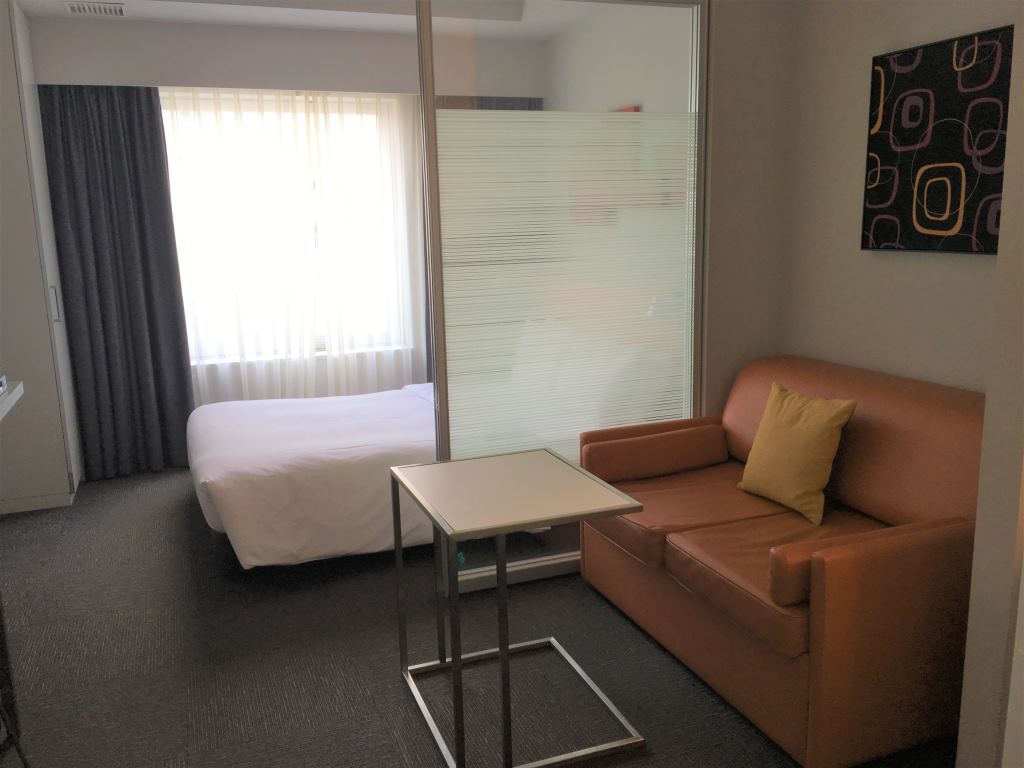
Admittedly, most hotel rooms in Tokyo are on the small side – but the Citadines Shinjuku breaks the mold. It’s an apartment hotel, and each room has a good-sized double bed, a sitting area, a kitchenette, and a full bathroom with a bath (which you’ll need after all the walking you’re likely to do). I’ve stayed here four times now and definitely recommend it.
Look at the size of that room.
If you’re not sure about the Citadines, but like the idea of a large hotel room, then have a look at our post on the best hotels in Tokyo with large rooms which gives a few more to choose from.
If you’re looking for other suggestions, or just need to get your Tokyo neighborhoods straight in your head, check out this guide on where to stay in Tokyo.
So there you have it—17 things you can do in Tokyo before 10 a.m. Did I miss anything?
Have you joined our Japlanease Facebook Group yet? It’s the perfect place to ask questions and get answers from me, and other Japan fans and travelers. Join it here.

Who Writes This Blog?
My name is Helen Foster, and I’m a journalist and author. My travel articles have appeared in publications including The Australian, RAC Horizons, Jetstar Magazine, Sainsbury’s Magazine, and more.
I’ve traveled to Japan five times before- solo and with my partner – and I’ve just returned from trip six in June 2023. So, everything here is pretty up to date.
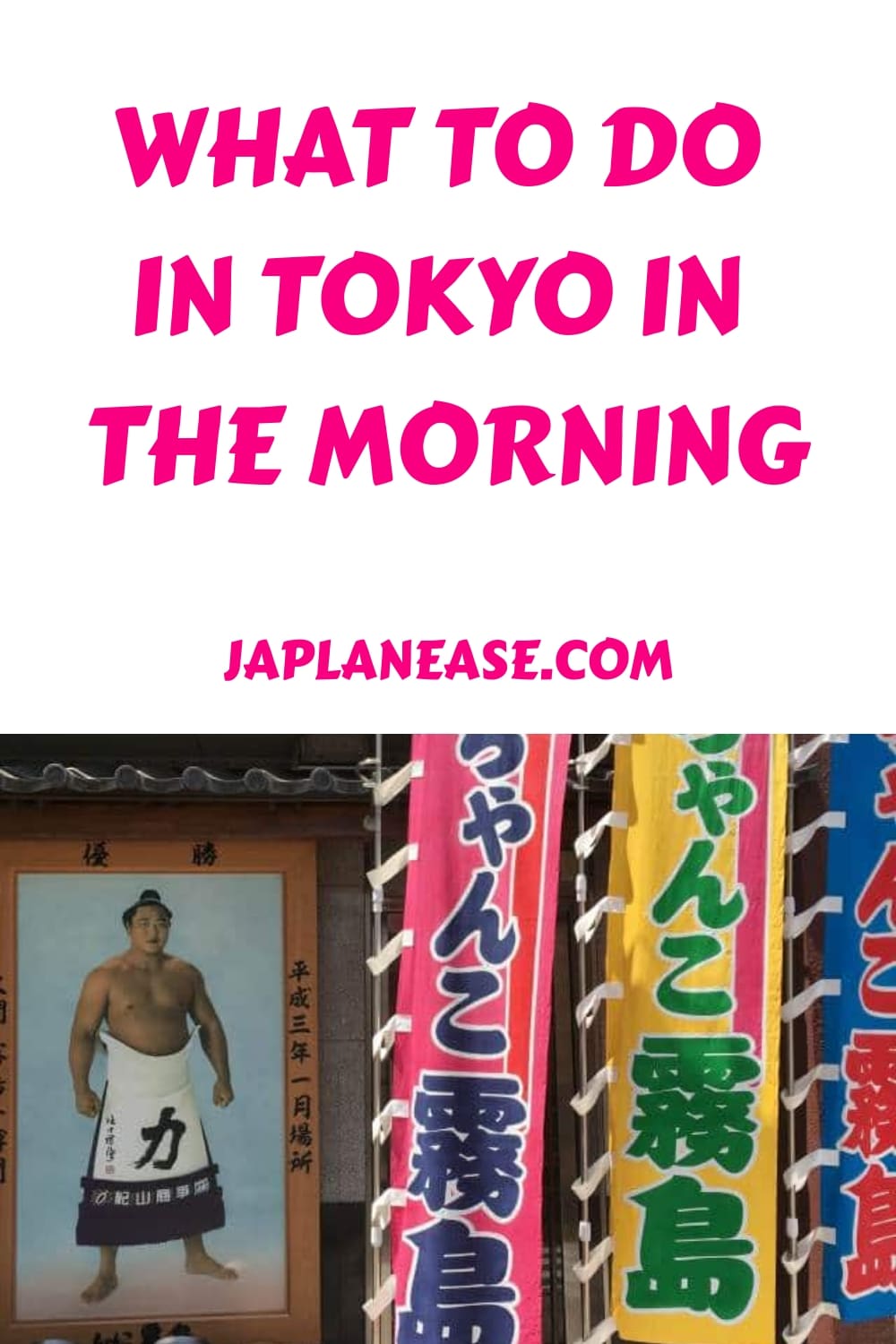

great idea! thanks!
My pleasure, hope you have a great trip.
Thank you for sharing! I love the Hachiko tour ideas so much. I’m planning to go to Shibuya tomorrow and by chance it will be exactly 3 months after my dog passed away. Before reading this, I only had planned to make a quick visit to Hachiko statue in Shibuya station. But thanks to you now I know that there’s even more touching statue at Todai. Definitely gonna go there tomorrow morning. I hope i wont cry there.
I had a little cry. His face is so happy!
Does Tokyo Skytree still open at 8AM up to now? I’ve checked all websites, all says that it’s not open until 10AM?
No. You’re right. It looks like that’s changed since COVID and it’s currently 10am. Thanks for pointing that out.